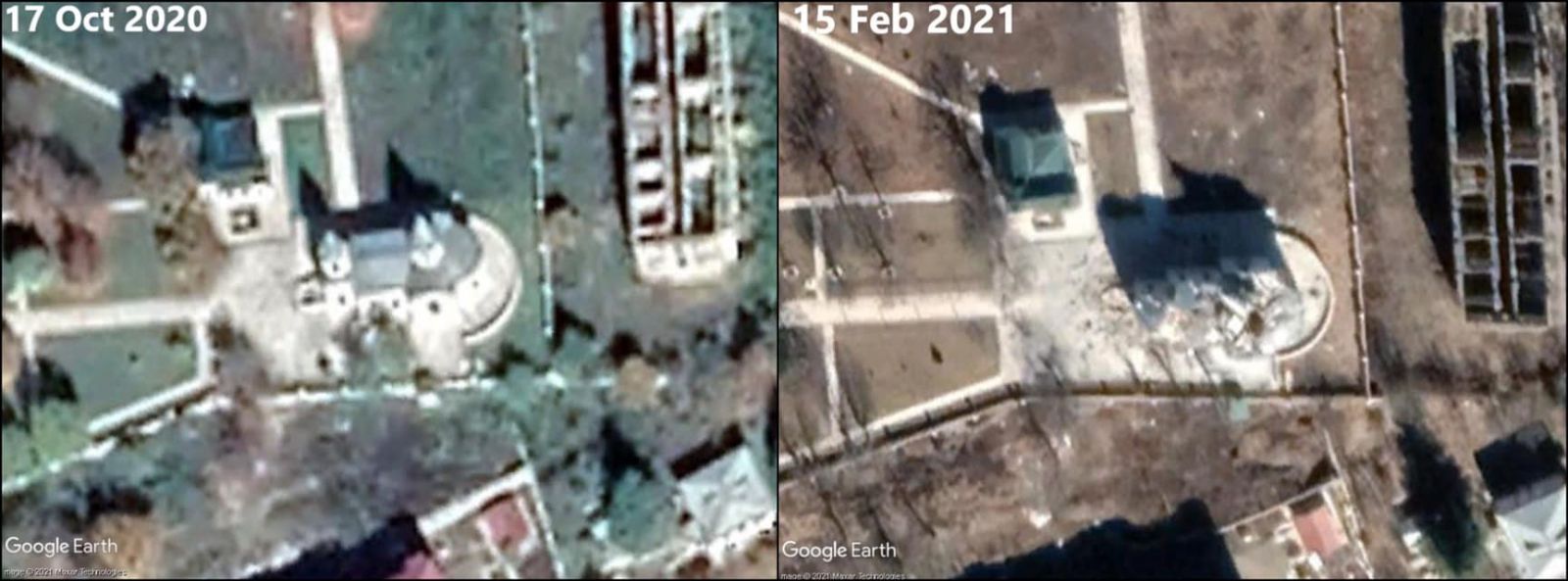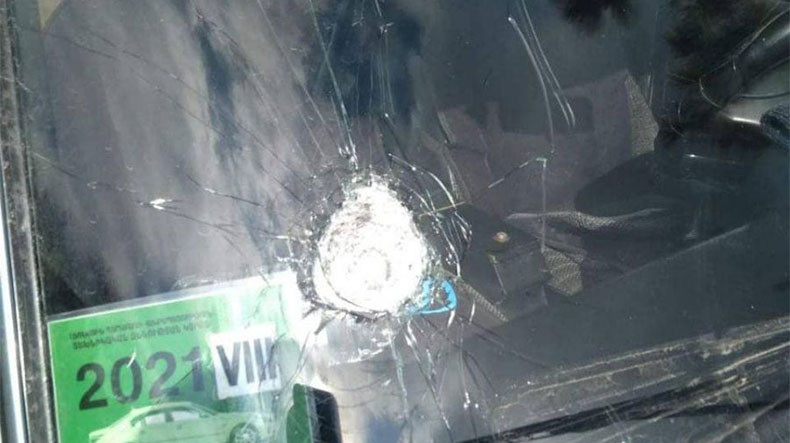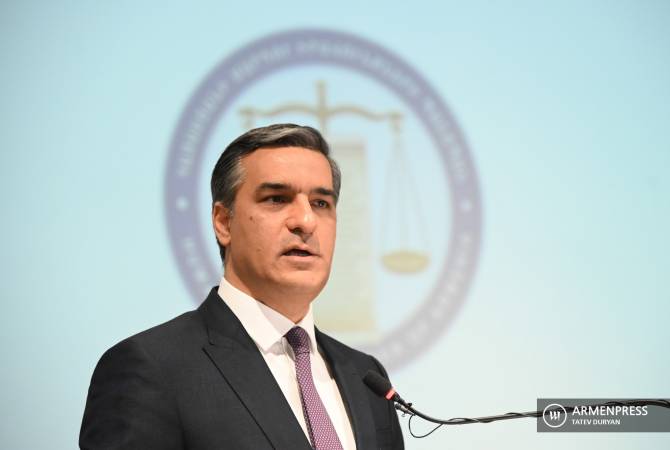(Berlin) – Azerbaijani forces abused Armenian prisoners of war (POWs) from the 2020 Nagorno-Karabakh conflict, subjecting them to cruel and degrading treatment and torture either when they were captured, during their transfer, or while in custody at various detention facilities, Human Rights Watch said today.
Azerbaijani authorities should investigate all allegations of ill-treatment and hold those responsible to account. Azerbaijan should also immediately release all remaining POWs and civilian detainees and provide information on the whereabouts of servicemen and civilians whose situation is unknown but were last seen in Azerbaijani custody.
“The abuse, including torture of detained Armenian soldiers, is abhorrent and a war crime,” said Hugh Williamson, Europe and Central Asia director at Human Rights Watch. “It is also deeply disturbing that a number of missing Armenian soldiers were last seen in Azerbaijan’s custody and it has failed to account for them.”
Human Rights Watch interviewed four former POWs who detailed their ill-treatment in custody as well as the ill-treatment of other POWs with whom they were captured or shared cells. They all described prolonged and repeated beatings. One described being prodded with a sharp metal rod, and another said he was subjected to electric shocks, and one was repeatedly burned with a cigarette lighter. The men were held in degrading conditions, given very little water and little to no food in the initial days of their detention.
Scores of videos showing scenes in which Azerbaijani officers can be seen apparently ill-treating Armenian POWs have been posted to social media. Human Rights Watch closely examined and verified more than 20 of these videos, including through interviews with recently repatriated POWs and family members of servicemen who appear in the videos but have not yet returned. Human Rights Watch also reviewed medical documents.
The accounts of torture and ill-treatment raise concerns that Armenian POWs still in Azerbaijani custody are at risk of further abuse, Human Rights Watch said. Azerbaijani authorities should ensure that Armenian POWs and other detainees still in custody have all the protections to which they are entitled under international human rights and humanitarian law, including freedom from torture and ill-treatment.
The armed conflict between Armenia and Azerbaijan over Nagorno-Karabakh escalated on September 27, when Azerbaijan began a military offensive. Hostilities ended on November 10 with a Russia-negotiated truce. The peace agreement provided, among other things, for “an exchange of prisoners of war and other detained persons and bodies of the dead.”
The number of Armenian POWs still in custody remains unclear. By the end of February 2021, Armenia’s Representative Office at the European Court of Human Rights had asked the court to intervene with Azerbaijan regarding 240 cases of alleged prisoners of war and civilian detainees. In approximately 90 percent of those cases, the office said, they had provided photo and/or video evidence confirming that Azerbaijani forces had taken these people into custody.
Armenia’s leadership said that Azerbaijan has returned 69 POWs and civilians. Azerbaijani President Ilham Aliyev said that his government has returned all the POWs to Armenia but was still holding approximately 60 people as terrorism suspects. Human Rights Watch is not in a position to verify the claims by Azerbaijan or Armenia about the numbers of people remaining in custody or their status.
An Armenian Foreign Ministry representative in Yerevan told Human Rights Watch on February 24 that families are “increasingly desperate” to find their loved ones, especially in light of numerous credible reports of prisoner abuse.
All four former POWs who spoke with Human Rights Watch had been wounded before their capture. In one case, Human Rights Watch documented, an Azerbaijani officer provided first aid to a wounded Armenian soldier shortly after capturing him. Another Azerbaijani officer gave pain medication to another POW. One former POW said the commanding officer told his subordinates not to hit the POWs but that as soon as the commanding officer was no longer present, the soldiers would abuse them.
International humanitarian law, or the law of armed conflict, requires parties to an international armed conflict to treat POWs humanely in all circumstances. The third Geneva Convention protects POWs “particularly against acts of violence or intimidation and against insults and public curiosity.” Azerbaijan is also bound by the absolute prohibition on torture and other degrading or inhuman treatment in international law as articulated in both the International Covenant on Civil and Political Rights (ICCPR) and the European Convention on Human Rights (ECHR), to which it is a party.
“We heard accounts and viewed images of prolonged and repeated beatings of Armenian prisoners of war, designed, it seems, solely to humiliate and punish them,” Williamson said. “Torture and ill-treatment of prisoners of war constitute war crimes for which accountability is urgently needed.”
For additional details and former POWs’ accounts, please see below.
In February, in Armenia and Nagorno-Karabakh, Human Rights Watch interviewed four former POWs who were captured under different circumstances and in different locations during the active fighting between October 15 and November 20 and returned to Armenia on December 14. They were among 44 POWs and civilians whom Azerbaijani authorities repatriated on a special flight from Baku to Yerevan.
Abuse During Capture in Nagorno-Karabakh
Three of the four soldiers were beaten by Azerbaijani forces immediately following their capture and/or during their transfer to the first detention site.
Davit (not his real name), 19, said that the Azerbaijani officer who captured him on October 15, on the outskirts of Hadrut, treated him humanely. The officer applied a tourniquet to stop the bleeding from his lower leg wound, gave him water, carried him to the nearby Azerbaijani camp, reassured him he would be taken to a hospital for treatment, and watched over him to make sure that other soldiers left him alone. However, when a vehicle arrived to drive Davit to a hospital in Baku, where he then spent several days, things changed:
They tied me up and threw me in the back of the car, face down, my hands handcuffed behind my back. Once they hit the road, one of [the Azerbaijani servicemen] started yelling at me and pummeling me with his punches. He had something like a windproof lighter and burned my hands with it. He used it to heat up a metal rod and poked me in the back with the rod. I fainted from the pain. When we arrived at the hospital, I was barely conscious. All my muscles were clenched. I could not move, could not speak. They threw me on a stretcher. I spent four to five days in the hospital, my left arm cuffed to the bed with two guards watching me round the clock. Sometimes, when the medical workers did not see, [the guards] punched me, mostly on the head.
When Human Watch interviewed Davit on February 22, the scars from the burns on his hands and back were still visible.
Tigran, 20, was captured in Hardut district on October 20 with eight other Armenian soldiers, by a large group of Azerbaijani forces. A video, widely circulated on social media, showed Azerbaijani forces kicking, stepping on, and dragging the Armenian soldiers.
“They started beating us straight away and kept it up for three hours or so,” Tigran said. “Their commanding officers told them not to. But whenever those officers weren’t around, the beating resumed… They gave a spade to one of ours and told him to go dig his grave. He was so frightened he started digging.”
The soldiers also used a metal rod to poke the men who were tied up. Tigran, who was wounded, weak, and disoriented, does not recall the details of being poked but after he was transferred to a detention facility, he saw two puncture wounds on his body, apparently from the rod.
Abuse in Alleged Military Police Custody
Three of the former POWs spent three to five days in the custody of what they understood was the Azerbaijani military police in Baku. Two of them, interviewed separately, said they were kept in separate rooms; one was held in a room with another Armenian POW. All three said they were handcuffed to a radiator in a position that would not allow them to lie down and had neither mattresses nor blankets. Once a day, the guards took them to the toilet, where they could also drink some water from the tap. Other than that, they were given no food or water. None received any treatment for injuries they had. Officers regularly entered their cells, screamed at them, punched, kicked, and beat them with wooden rods. Davit said:
I almost did not sleep there. At first, I would doze off, but they would come and beat me up so badly that I would not sleep out of fear again… They came in groups of two to four. One of them broke his wooden rod on me, hitting me so badly that I lost the use of my arm for a while. On my fourth day there, they beat me so badly that they actually broke two ribs.
Hovhanness, 45, captured on October 19, spent three days in that facility, alone in a room on the first floor. He said that several times a day, five to ten soldiers would come into the room to beat him with their fists, booted feet, clubs, and a metal rod. On multiple occasions late at night, his captors also forced him to perform exercises for two hours and beat him for his supposedly poor performance. On other occasions, they forced him face down on the floor, ordered him to lie still for two hours, left, and then returned and beat him for changing his position. Hovhanness received no food during the entire three days and if the guards or soldiers found him asleep, they would wake him.
Levon, 31, captured in Magadis on October 22 with another seven Armenian soldiers emphasized that the beatings were intended as punishment. Levon had multiple wounds he had received before he was detained, but that did not deter the Azerbaijani soldiers from beating him repeatedly and brutally:
It began as soon as we were brought to the military police in Baku – they beat us nonstop for one-and-a-half to two hours, pushing us to the ground, punching, and kicking us, two or three of them working on each of us. Once we were in the cells – I was put in a cell with another man from our group – they would run in, in small groups, several times a day and beat us. They did not interrogate us, did not really ask any questions, except things like, “Why did you join the fighting?”
They showed us some video from Ganja [second-largest city in Azerbaijan, where 32 civilians were killed by Armenian artillery strikes in October] … screamed at us and hit us. They mostly beat us on the arms and the upper body. My upper arms were literally black and blue. They yelled, they blamed us for… [killings of Azerbaijani civilians during the first war] and beat us… I actually told them, “I was two years of age at the time! … If you want to ask me any question, all it takes is to ask. If you want to kill me, just kill me. But do not do this to me!
Abuse in National Security Ministry Detention
All four of the former POWs were later transferred to the National Security Ministry detention facility in Baku, where they spent weeks being interrogated by Azerbaijani security services. They said that they received three meals a day, although the portions were small and the food was poor quality, and that medical workers examined their wounds and provided basic treatment. However, between interrogations, they were all beaten with fists, booted feet, and clubs.
Tigran described being tortured with electric shocks twice. On the first occasion, the torture went on for approximately 40 minutes. He said that every time he lost consciousness from pain, his torturers revived him and gave him more shocks. On the second occasion, the torture went on for approximately 10 minutes.
The Azerbaijan military forced all the POWs to speak on camera, in professional recordings, saying they did not want to fight in the war, blaming the Armenian government for their plight, and stating that Nagorno-Karabakh is part of Azerbaijan. Davit said his video was fully scripted and that when he did not get it right, an officer threatened him with an electric shock.
Hovhanness spent approximately 50 days at the National Security Ministry detention facility, having been transferred from the military police. He said that the guards entered his cell every day to kick and punch the inmates and that they beat him with clubs three or four times in the course of his detention. The beatings mostly took place in the cell and sometimes they went on as late as midnight. One of the blows damaged his kneecap and his knee still pained him at the time of his interview:
“They were hitting me even in front of the doctor [who changed the bandage on his wound during the first week he spent at the ministry’s detention facility]. They were beating every day and making us say ‘Karabakh [is] Azerbaijan’ every time they opened the cell.”
Humiliation, Insult at a Pre-trial Detention Facility in Baku
After several weeks at the Security Ministry detention center, the authorities transferred three of the four former POWs to the pre-trial detention facility No.1 in Baku’s Kurdakhani settlement. The former POWs described the conditions there as adequate and noted that they were not subjected to any physical abuse. They received a visit from the ICRC, which was able to connect them with their families. However, the guards called them names, forced them to chant “Karabakh-Azerbaijan,” and told them that Azerbaijan had taken over all of Nagorno-Karabakh and was advancing into Armenia, which caused them tremendous stress and made them fear for their families.
Applicable Legal Standards
The third Geneva Convention governs the treatment of prisoners of war in international armed conflicts, and articles 17, 87, and 89 all prohibit forms of torture and cruel treatment. Common Article 3 also prohibits “cruel treatment and torture” and “outrages upon personal dignity, in particular humiliating and degrading treatment,” torture or inhuman treatment, and “willfully causing great suffering or serious injury to body or health” constitute grave breaches of the Geneva Conventions and are war crimes. Both the International Covenant on Civil and Political Rights, in articles 7 and 10, and the European Convention on Human Rights, in article 3, prohibit all forms of torture, inhuman and degrading treatment or punishment, and require humane treatment of all those in custody.
 10:32, 4 March, 2021
10:32, 4 March, 2021





















